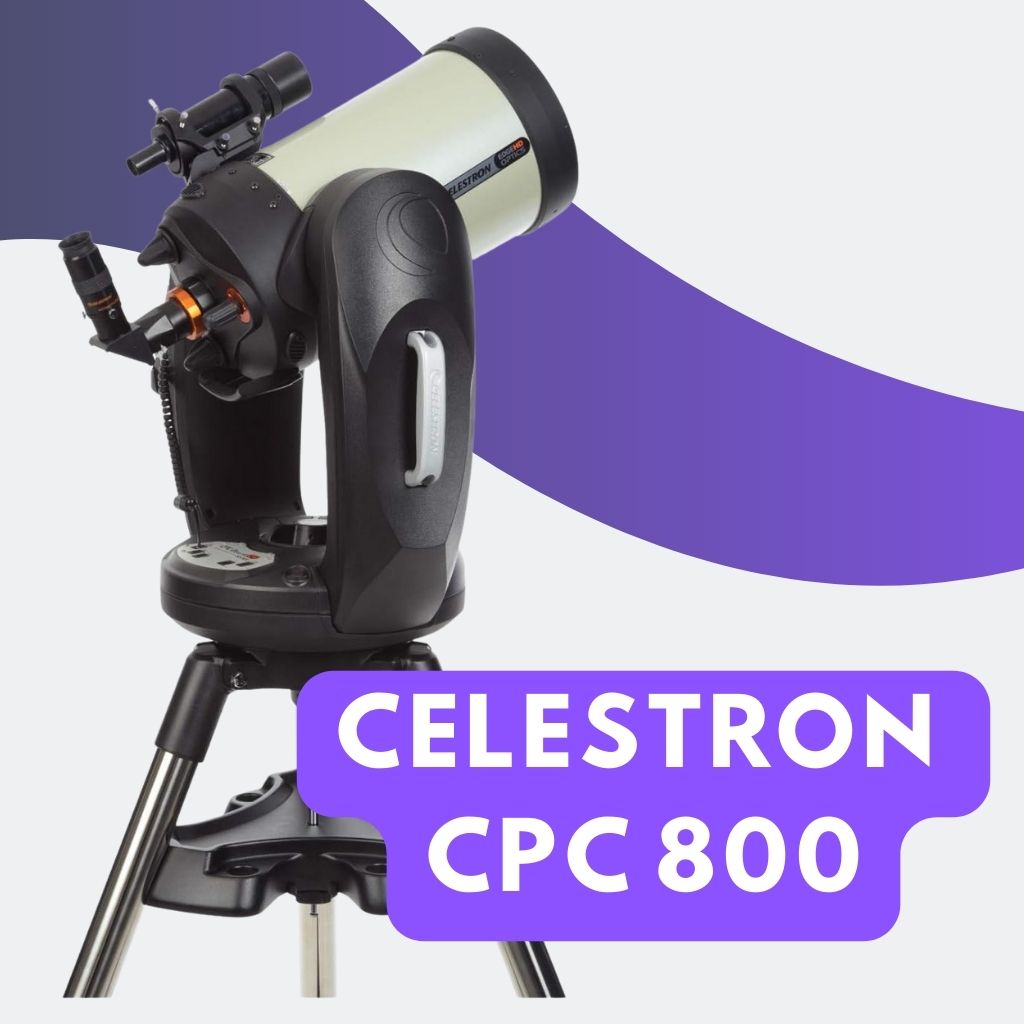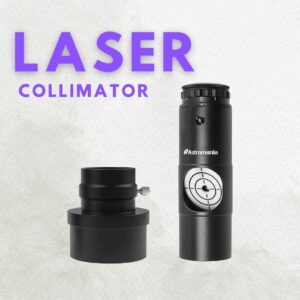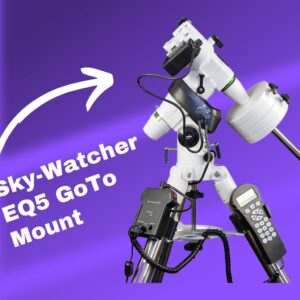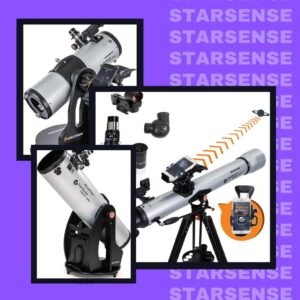This site contains affiliate links to products. I may receive a commission for purchases made through these links.
If you are an aspiring astronomer looking to take your stargazing to the next level or a seasoned observer, having the right telescope can make all the difference in stargazing.
With a multitude of options available, finding a telescope that strikes a perfect balance between advanced features and a solid reputation can be a daunting task.
However, fear not, as we bring you an in-depth review of the Celestron CPC 800 Telescope, a renowned instrument that has captured the attention of astronomy enthusiasts worldwide.
Celestron, a name synonymous with quality and innovation in the field of telescopes, has established itself as a trusted brand over the years. Their CPC 800 Telescope, part of the highly acclaimed CPC series, is designed to deliver exceptional performance while catering to both novice stargazers and advanced astronomers.
Packed with cutting-edge features and backed by a solid reputation, this telescope promises to open up a whole new world of celestial exploration.
This review will delve into the key features, pros, cons, and what you can see with the telescope.
Celestron CPC 800 GPS XLT telescope review, in a nutshell
The Celestron CPC 800 GPS XLT Telescope stands out in the market with its robust set of features and high performance.
Its strengths lie in its superior optics, effective GPS, and impressive object tracking, offering a unique blend of quality and accessibility that is suitable for a wide range of users, from beginners to more advanced astronomers.
However, its significant weight and somewhat complicated initial setup process may deter some users.
Yet, with its strong offerings and competitive price point, the CPC 800 is a good choice for those seeking a blend of value and performance.
Celestron CPC Deluxe 800 HD 8-inch CPC SCT Telescope
The Celestron CPC Deluxe 800 HD 8-inch CPC SCT Telescope is part of Celestron’s CPC product line.
Equipped with an 8-inch aperture, this telescope can reveal the intricate details of the moon’s craters, views of planets, and even distant galaxies and nebulae.
It leverages Celestron’s High Definition optical system for sharp, high-contrast imagery. One of its strengths is its computerized dual fork arm mount with GPS, enabling precise locating and tracking of celestial objects.
However, this telescope is quite heavy and may not be as portable as other models. It’s also a significant investment, falling in the higher price range of telescopes, but for the serious stargazer, it’s an investment well worth making.
Celestron CPC 800 GPS XLT Telescope vs Celestron CPC Deluxe 800 HD 8-inch CPC SCT Telescope
The Celestron CPC Deluxe 800 HD and the Celestron CPC 800 GPS XLT are similar, but they are not the same telescope.
While they share many features, such as the 8-inch aperture and the computerized dual fork arm mount with GPS, the CPC Deluxe 800 HD is a more advanced model.
The main difference between the two lies in the optical system. The CPC Deluxe 800 HD uses Celestron’s EdgeHD optical system, designed to produce aberration-free images with pinpoint stars all the way to the edge of the field of view.
The EdgeHD system also reduces star elongation, which can be especially useful for astrophotography.
The CPC 800 GPS XLT, on the other hand, uses Celestron’s older XLT optical system. It’s still a high-quality system, but it doesn’t offer the same level of performance as the EdgeHD system in the CPC Deluxe 800 HD.
Both telescopes are solid options for stargazing. The CPC 800 GPS XLT provides excellent value, while the CPC Deluxe 800 HD offers enhanced image quality, especially for those interested in astrophotography.
What can you see with the Celestron CPC 800 Telescope?
The Celestron CPC 800 Telescope is a highly recommended companion for your observing sessions, providing an excellent choice for exploring a diverse array of celestial objects.
With its versatile capabilities, this telescope allows you to witness a rich assortment of several solar system objects, including:
Planetary bodies
The CPC 800 brings the heavens down to Earth. With an aperture of 8 inches, this telescope presents the opportunity to observe the rings of Saturn, the bands of Jupiter, and even Mars’ ice caps during optimal viewing conditions.
Although challenging to observe due to its proximity to the Sun, the Celestron CPC 800 Telescope can help you catch glimpses of Mercury during its greatest elongation from the Sun.
With their fainter appearances, Uranus and Neptune may appear as small, bluish-green discs. However, the Celestron CPC 800 Telescope can still detect their presence.
Deep sky objects
Due to its large aperture and superior optical quality, this telescope can extend your sight beyond our solar system. It allows for detailed views of galaxies, nebulae, and star clusters, which will be sure to impress even the most experienced observers.
Moon
Celestron CPC 800’s high-resolution views transform the moon from a distant celestial body into a close neighbor. Its craters, valleys, and mountains become detailed features you can explore at leisure.
Is the Celestron CPC 800 Telescope good for beginners?
Despite its professional-grade features, the CPC 800 is highly accessible to beginners. The telescope’s intuitive GoTo mount and automated tracking system simplify the process of locating and observing celestial objects.
This, coupled with a comprehensive database of over 40,000 celestial objects, ensures that beginners can easily start their stargazing journey.
The auto two-star align feature of the CPC 800 simplifies the alignment process.
By utilizing the SkyAlign technology, users can easily align the CPC 800 by selecting and centering three bright celestial objects, ensuring accurate tracking and precise object location.
Is the Celestron CPC 800 Telescope good for astrophotography?
Celestron CPC 800 is not just a device for stargazing but a strong contender for astrophotography as well.
Its robust tracking capabilities, superior optical systems, and built-in features specially designed for astrophotography provide a comprehensive platform for those interested in capturing the ethereal beauty of celestial bodies.
You may also like: 15 Best Telescopes for Astrophotography (Full Guide)
Advanced astrophotography features of the Celestron CPC 800 Telescope
The Celestron CPC 800 Telescope is specially designed with advanced features for astrophotography, making it great for capturing beautiful pictures of the moon, planets, and other celestial objects.
Let’s take a closer look at these features and how they enhance your astrophotography experience.
Built-in wedge for long-exposure astrophotography
With the built-in wedge, the CPC 800 telescope facilitates long-exposure astrophotography by providing a much-needed stable platform.
The equatorial wedge enables the scope to mimic the Earth’s rotational axis, which is essential for long-exposure photography.
Without it, celestial objects can trail in the image, leading to blurry pictures. The built-in wedge enhances accuracy in tracking objects for extended periods, making it possible to capture stunning images of deep-sky objects.
Compatible with DSLR cameras
The CPC 800 is designed to accommodate DSLR cameras seamlessly. It has a removable secondary mirror, allowing it to be replaced with a DSLR camera for prime-focus photography.
This feature opens up the world of high-resolution, wide-field astrophotography, letting you capture detailed images of galaxies, nebulae, and star fields.
Faster compatibility for wide-field imaging
The telescope also incorporates features that make it perfect for wide-field imaging. With faster optics and compatibility for wide-field imaging, users can capture expansive swaths of the night sky in great detail.
This feature is particularly useful for capturing large-scale celestial events like meteor showers or photographing larger celestial objects like the Milky Way.
Pros of the Celestron CPC 800 Telescope
The Celestron CPC 800 Telescope offers a host of advantages that make it a standout.
Here are some of its top strengths:
Superior optics
The CPC 800 comes with Celestron’s proprietary StarBright XLT optical coatings, significantly enhancing the telescope’s performance. This multi-layer coating increases light transmission across the entire visible spectrum.
The result is brighter, clearer images with excellent color fidelity, essential for both observation and astrophotography.
The Schmidt Cassegrain optical tube of the CPC 800 combines the advantages of both reflector and refractor telescopes, offering compactness and excellent light-gathering power for impressive astronomical observations.
Effective GPS
One of the unique features of the CPC 800 is its built-in GPS, a feature that sets it apart from many other models in its category. The GPS automatically syncs the date and time, eliminating the need for manual entry.
It also assists in accurately aligning the telescope to the North, which is crucial for the telescope’s GoTo function.
This automatic feature significantly simplifies the setup process, making it easier for beginners.
Intuitive GoTo mount
The CPC 800 features a computerized GoTo mount that can automatically slew the telescope to any of over 40,000 objects in its database.
This means that even beginner astronomers can easily locate celestial objects without having to navigate manually.
The database includes a wide range of celestial objects, including galaxies, nebulae, star clusters, planets, and more, effectively making the entire universe accessible at the touch of a button.
Cons of the Celestron CPC 800 Telescope
While the Celestron CPC 800 Telescope offers a range of exceptional features, it’s important to consider its limitations as well.
Every telescope has its drawbacks, and the Celestron CPC 800 is no exception.
Let’s explore some of the cons associated with this telescope, helping you make an informed decision about its suitability for your specific needs.
Heavy weight
The CPC 800 is not the most portable of telescopes. While its sturdy construction contributes to its stability and durability, it may pose challenges in terms of transportation and storage.
It’s worth noting that the telescope’s weight could be a deterrent for those who wish to frequently transport their equipment for observations under different skies.
Initial setup complexity
Although the CPC 800 is ultimately user-friendly, its initial setup process can be somewhat daunting, particularly for beginners. From assembling the parts to aligning the telescope, the setup requires a certain degree of patience and learning.
This might pose a slight hurdle to individuals new to the hobby. However, with a comprehensive user manual and numerous online resources, users can become comfortable with the process over time.
Features of Celestron CPC 800 Telescope
The Celestron CPC 800 Telescope is packed with a range of features that elevate your astronomical observations.
Here are some notable features:
Celestron CPC 800 weight
The Celestron CPC 800 is a substantial piece of equipment weighing 64 pounds, approximately 29.03 kilograms. This includes the weight of the optical tube, the mount, and the tripod.
While its weight indicates its robust construction and quality, it’s something to consider in terms of portability.
Aperture of the Celestron CPC 800 Telescope
The telescope boasts an impressive 8-inch (203mm) aperture. This large aperture allows the CPC 800 to gather more light, providing bright, clear images of distant celestial objects.
It is ideal for observing faint objects like distant galaxies and nebulae.
Focal length of the Celestron CPC 800 Telescope
The CPC 800 has a long focal length of 2032mm, giving it a focal ratio of f/10. This contributes to the telescope’s ability to provide high-magnification views.
This makes it excellent for observing small and distant celestial objects like planets and tight star clusters.
Magnification of the Celestron CPC 800 Telescope
The telescope’s highest useful magnification is 480x. This means it can enlarge objects up to 480 times larger than what they would appear to the naked eye.
However, keep in mind that the clarity of the images at such high magnification levels depends largely on the observing conditions.
Computerized mount and GoTo Functionality
The CPC 800 features a computerized altazimuth fork mount with Celestron’s proven NexStar computer control technology. The GoTo functionality allows the telescope to automatically slew to any of the over 40,000 celestial objects in its database.
This makes it easy to locate and track objects in the night sky.
Precision motorized tracking
With its high-precision motor drives, the CPC 800 provides accurate tracking. Once an object is centered in the eyepiece, the telescope can track it across the sky, compensating for the Earth’s rotation.
This is particularly useful for astrophotography, where precise tracking is necessary.
Integrated database of celestial objects
The telescope’s hand controller features an integrated database of over 40,000 celestial objects.
This includes a wide range of objects, such as galaxies, nebulae, star clusters, and planets, effectively bringing the universe to your fingertips.
Celestron CPC 800 Telescope key specs
Here are some of the key specs of this telescope:
| Specifications | Description |
| Optical Design | Schmidt-Cassegrain |
| Optical Coatings | StarBright XLT |
| Mount Type | Computerized dual fork arm Altazimuth mount |
| Finder Scope | Reflex |
| Eye Piece Lens Description | Plossl |
Accessories included with the Celestron CPC 800 Telescope
Under the Celestron CPC 800 Telescope, you can expect to find a variety of accessories carefully selected to enhance your observing experience.
These accessories, designed to complement the telescope’s capabilities, offer additional functionality and convenience.
Let’s explore the accessories included with the Celestron CPC 800 Telescope and discover how they can elevate your astronomical adventures.
9×50 finder scope
The 9×50 finder scope included with the Celestron CPC 800 XLT package provides a wider field of view and higher magnification to help you accurately locate celestial objects.
Its 9x magnification allows for easy alignment and positioning of the main telescope, making it an invaluable tool for finding your desired targets in the night sky.
40mm Plossl eyepiece
The 40mm Plossl eyepiece included in the Celestron CPC 800 XLT package offers a magnification of 50X, enabling you to observe celestial objects with a wider field of view.
This eyepiece is particularly useful for capturing breathtaking panoramic views of star clusters, nebulae, and larger celestial structures.
Star diagonal
The star diagonal enhances the comfort and convenience of observing celestial objects by providing a convenient viewing angle.
Typically placed between the eyepiece and the telescope’s optical system, the star diagonal reflects light at a 90-degree angle, allowing observers to view objects from a more comfortable position.
Instead of straining your neck or contorting your body to look straight through the telescope, the star diagonal enables you to observe objects in a more natural and relaxed posture.
NexStar computer hand control
The NexStar computer hand control is a key accessory included in the Celestron CPC 800 XLT package. With this handheld device, you can easily operate and control the telescope’s movements.
The NexStar computer hand control provides access to a comprehensive database of celestial objects, allowing you to select and track specific targets with precision and convenience.
12-volt car battery adapter
The Celestron CPC 800 XLT package includes a 12-volt car battery adapter, offering a versatile power source option for your telescope.
This adapter allows you to power your telescope using a car battery, providing portability and convenience for remote observing sessions.
With this accessory, you can extend your observing time without worrying about running out of power.
How to set up the Celestron CPC 800 Telescope
Setting up the Celestron CPC 800 Telescope is a straightforward process that allows you to quickly embark on your stargazing journey.
Here is a step-by-step guide on how to set up your Celestron CPC 800 Telescope, ensuring a smooth and hassle-free experience.
- Begin the setup by positioning the tripod on a flat and stable surface, extending the legs to the desired height, and securing them in place.
- Place the fork arm and optical tube assembly onto the tripod. Ensure the assembly is secured firmly on the tripod.
- Mount the finderscope onto the telescope, ensuring it is securely fitted.
- Select the desired eyepiece and insert it into the eyepiece holder at the rear of the telescope.
- Power on the telescope and enter the date, time, and location into the hand controller. Follow the prompts on the controller for aligning the telescope.
Remember, reading the manual thoroughly before setting it up can help you understand the process better and avoid potential pitfalls.
What additional accessories do I need to buy with the Celestron CPC 800?
While the Celestron CPC 800 is ready to use out of the box, there are several additional accessories you might consider to enhance your stargazing experience. Here are some of them:
Eyepieces & filters
The telescope comes with a 40mm eyepiece, but you might want to invest in additional eyepieces of different focal lengths to vary the magnification.
Celestron Accessory Kit is a comprehensive package that includes a variety of eyepieces and filters designed to enhance your observing experience
Barlow lens
A Barlow lens like the Celestron X-Cel LX 2x Barlow Lens can double the magnification of your eyepieces, offering more detailed views.
Power supply
If you plan on using the telescope in remote locations, consider purchasing a portable power supply like the Celestron PowerTank Lithium Pro.
Carrying case
A carrying case, such as the Celestron Carrying Case for NexStar Optical Tubes, can protect the telescope during transportation and storage.
Camera adapter
If you’re interested in astrophotography, a camera adapter like the Celestron T-Ring and T-Adapter can help connect your DSLR camera to the telescope.
FAQs about Celestron CPC 800
Let’s address some frequently asked questions.
Should I buy a fairly used Celestron CPC 800 GPS telescope?
Buying a used Celestron CPC 800 GPS telescope can be a good idea, especially if you are budget-conscious. However, you have to thoroughly inspect the telescope before purchasing.
Check for any visible damage to the optical system, mount, or electronic components. Request a demonstration to ensure that the telescope functions properly, including the motorized tracking and GoTo functionality.
Does the Celestron CPC 800 have a warranty?
Celestron offers a two-year warranty for the CPC 800 GPS XLT telescope, covering any defects in materials and workmanship.
This warranty gives users peace of mind and reflects Celestron’s commitment to the quality of their products.
Takeaway: The Celestron CPC 800 is a powerful telescope for observing solar system objects
The Celestron CPC 800 GPS XLT telescope is a remarkable blend of advanced features and user-friendly functionality.
The 8-inch aperture, long focal length, precision motorized tracking, and integrated database of over 40,000 celestial object makes this telescope stand out in its category.
With the telescope control software, users can easily operate and command the CPC 800, accessing advanced features and functionalities.
The secondary mirror obstruction, a common characteristic of Schmidt-Cassegrain telescopes like the CPC 800, is carefully designed to minimize any impact on image quality.
The CPC 800 computerized telescope optical system, consisting of high-quality lenses and mirrors, delivers exceptional clarity and sharpness for breathtaking views of the night sky.
Observers using the CPC 800 may notice a few dark markings on certain celestial objects, revealing fascinating details and characteristics that are often overlooked with other telescopes.
Though it’s not the most portable telescope due to its weight, and the initial setup might be a bit complex for absolute beginners, these are minor issues when considered against the wealth of features and capabilities it brings to the table.
You may also like:
- Is Celestron a Good Telescope Brand?
- Celestron NexStar 4SE Telescope Review
- Celestron NexStar 8SE Telescope Review
- National Geographic Telescopes (All models)
- National Geographic NT114CF Telescope Review
- Celestron NexStar 130 SLT Telescope Review
- Celestron NexImage 10 Camera Review
- SVBONY SV105 Camera Review
- Are GoTo Telescopes Worth It






